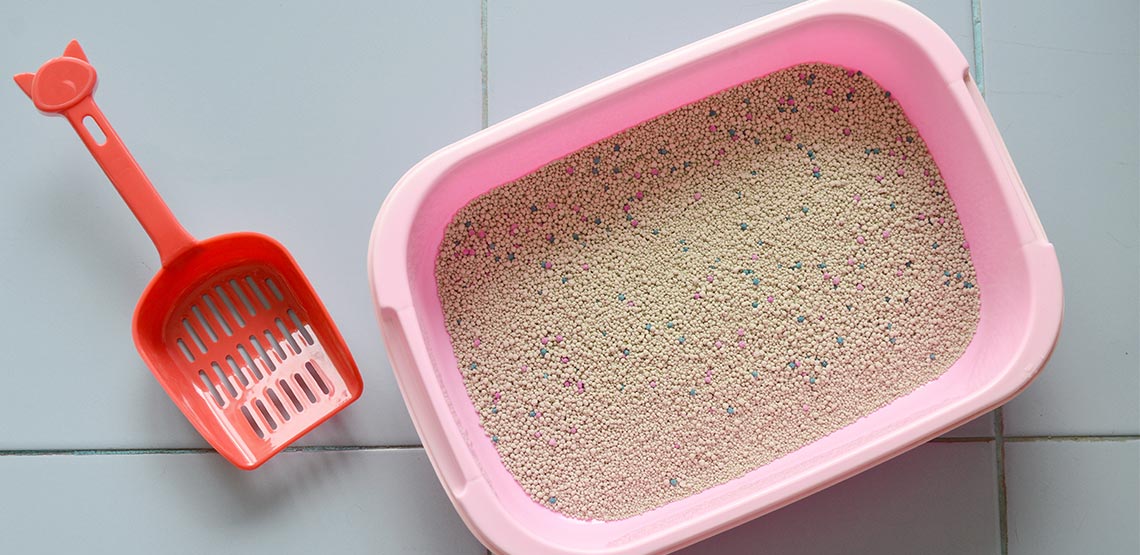Keeping Your Cat Happy
Whether you already own a cat or are planning on getting one, cat litter is an important supply. There are several types of cat litter to consider using. It’s better to be armed with information because your cat might reject whichever one you think is the best. If this happens, you should be ready to offer it a new option.
What to Look for When Choosing Cat Litter
If you don’t have any experience with cat litter, make sure to consider these factors when choosing one.
- Smell: If cat litter has a strong scent, the cat may reject it. No matter how great it smells to you, don’t buy it. The smell should be light.
- Texture: The most easy-to-maintain litters contain large elements. Think about the way you’ll be cleaning up if the cat throws the litter out of the box. Tiny particles will be flying all over your house. Bigger elements are easier to collect.
- Price: Cats get used to the litter you start them off with (if they don’t reject it, of course). So if you are buying an expensive one, be ready to keep paying for it for years, or struggling with a replacement.
- Clumping or Non-Clumping: Clumping litters absorb liquid and form large clumps inside the box, leaving the rest of the litter nice and clean. You can remove the clump, add some litter, and allow the cat to keep using the box. Non-clumping litters act like filters, allowing the liquid to pass through, removing the odor, and letting it dry.
- Packaging: If you opt for non-clumping litter, you’ll probably need to buy large packages since it needs to be changed at least once a week. Check if the litter you choose comes in convenient packaging that you can lift and carry.
5 Popular Types of Cat Litter
Clumping Clay Cat Litter
This is the most popular cat litter in the world. It’s easy to use since you only need to scoop the clumps and feces out. You rarely have to replace the whole box. You need to keep adding small amounts of litter so a big litterbox can go on without washing for a few months.
Since you use only small amount, clumping clay allows you to save a substantial amount of money. Cheaper types of clumping clay litter may stick to your cat’s paws.
Pros:
- Inexpensive
- Good odor control
- Easy maintenance
- Long lasting
Cons:
- Small particles (cats may throw them out of the box and they are hard to clean)
- Rather dusty
Natural Clumping Cat Litter
Unlike clumping clay litter, this one is made of natural plant fiber. This eliminates the dust factor and produces a slight natural scent. As for the rest, it works just like its clay counterpart. In fact, you may even need to replace it less often. Natural clumping litter acts as a great odor filter. It’s easy to scoop out. Cats often like natural litters better than clay ones.
Pros:
- Natural ingredients
- Good smell
- Easy to replace
- Not dusty
Cons:
- High price
Related Search Topics (Ads):
Silica (Crystal) Cat Litter
This is another popular type of cat litter. It’s a non-clumping option, which filters urine through the particles and allows it to dry. You scoop out the solids and replace the crystals about once a week, depending on the size of your cat. This litter offers good odor control. The best part is that you don’t need to scoop out large clumps of wet litter.
This type is not dusty. If some crystals roll out of the box while the cat is digging, they are easy to collect, and the crystals don’t stick to the cat’s paws.
Pros:
- Easy to replace
- No clump scooping
- Easy to clean up if spilled
- Good odor removal
Cons:
- Needs to be replaced once a week hence higher price
- Comes in heavy packages
Pine Litter
This is another natural litter option. It’s made of wood shavings and usually comes in the shape of pallets. It’s biodegradable and flushable, which substantially reduces the cleaning hassle. Pine pellets absorb liquid and turn into sawdust. You need to scoop out the sawdust after each toilet trip. Otherwise, it may stick to the cat’s paws and spread all over your floor.
This litter comes with a strong odor, which may turn some cats away.
Pros:
- Biodegradable and flushable
- Good odor control
- Lightweight
- Moderately priced
Cons:
- Strong scent
- Frequent cleaning with a slight learning curve
Biodegradable Litter
There are several types of biodegradable litter on the market. Pine is the most popular option. The rest can be made of sawdust, wheat, corn, or paper. These litters are environmentally friendly. They can be flushed down the toilet.
They are fairly easy to scoop. Many biodegradable litters produce a strong scent. Some cats may not appreciate using such a litter after they have gotten used to something else. However, the switch is possible by slowly adding one to the other over time.
Pros:
- Environmentally friendly
- Flushable
- Food odor control
- Good absorbency
Cons:
- Frequent cleaning
- Dusty
Which Litter Is Right for Your Cat?
Start with the litter you like the best. Clumping clay litter is the most popular product on the market today. You can start with this one and go from there.
If you are looking for an environmentally friendly litter, consider starting with pine. Then you can check out other granular biodegradable litters, such as wheat and barley. Remember, eco-friendly litters are sticky and often cause tracking.
